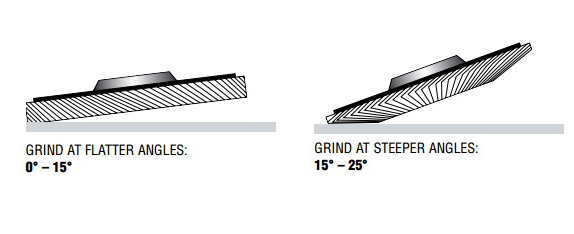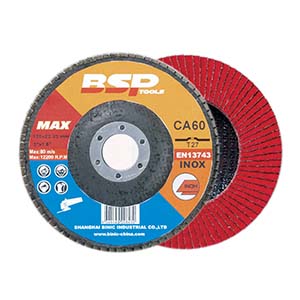What is a flap disc?
A flap disc is an abrasive tool used for grinding, polishing, and finishing various types of surfaces. It is made up of a circular disc that consists of overlapping abrasive flaps or pieces of sandpaper, each attached to a backing material. The flaps are made of different materials such as aluminum oxide, zirconia alumina, or ceramic, depending on the application and the type of material being worked on.
Flap discs are used with angle grinders or other handheld power tools, and they come in different sizes, grits, and shapes. They are versatile and can be used on a wide range of materials such as metals, plastics, woods, and composites. Flap discs are commonly used in metalworking, automotive repair, woodworking, and construction industries.
Compared to other grinding and finishing tools, flap discs offer several advantages such as faster stock removal, longer life, reduced heat buildup, and smoother finishes. They are also easy to use, versatile, and require less pressure to achieve a desired finish, which makes them a popular choice for many applications.
What should you notice before using a flap disc?
However, before using flap discs, there are some important things that you should know to ensure their safe and effective use. In this article, we will discuss some of the key factors that you should consider before using flap discs, including their types, sizes, grits, materials, and safety guidelines.
Types of Flap Discs:
Flap discs come in different types, and each type is designed for specific applications. Some of the common types of flap discs include Type 27, Type 28, and Type 29.
- Type 27 flap discs have a flat surface and are ideal for grinding flat surfaces and edges. They have a large surface area and can remove a lot of material quickly, making them a popular choice for heavy stock removal applications.
- Type 28 flap discs have a conical shape, and they are ideal for grinding and blending in hard-to-reach areas such as corners, fillet welds, and curved surfaces. They have a smaller surface area than Type 27 flap discs, making them ideal for more precise applications.
- Type 29 flap discs have a slightly angled shape and are ideal for contouring and finishing applications. They are designed to provide a smooth finish, and they are often used in finishing applications such as polishing and deburring.
Sizes and Grits:
Flap discs come in different sizes and grits, and the size and grit that you choose will depend on the application and the material being worked on. The size of flap discs ranges from 4 inches to 7 inches, and the grits range from coarse to fine. Coarse grits are used for heavy stock removal, while finer grits are used for finishing applications.
The most common sizes of flap discs are 4.5 inches and 7 inches, and these sizes are compatible with most angle grinders. The grits of flap discs range from 36 to 120, with 36 being the most coarse and 120 being the finest. The grit that you choose will depend on the application and the level of finish that you want to achieve.
Materials:
Flap discs are made of different materials, and the material that you choose will depend on the application and the material being worked on. The most common materials used in flap discs are aluminum oxide, zirconia alumina, and ceramic.
- Aluminum oxide flap discs are ideal for grinding and sanding soft metals such as aluminum and brass. They are also used for sanding wood and plastics.
- Zirconia alumina flap discs are ideal for grinding and sanding hard metals such as stainless steel and carbon steel. They are also used for heavy stock removal and deburring applications.
- Ceramic flap discs are ideal for grinding and sanding extremely hard metals such as titanium and inconel. They are also used for high-pressure applications that require high levels of durability and cutting power.
Safety Guidelines:
When using flap discs, it is important to follow safety guidelines to ensure their safe and effective use. Some of the safety guidelines to consider include:
- Wear the appropriate personal protective equipment (PPE), including safety glasses or goggles, a dust mask, and gloves.
- Inspect the flap disc before use to ensure that it is free of defects such as cracks, chips, or missing flaps.
- Use the correct size and type of flap disc for the application and the material being worked on.
- Do not exceed the maximum operating speed of the flap disc, which is usually printed on the disc or the packaging.
- Use the correct angle grinder for the flap disc,and ensure that it is properly maintained and in good working condition.Use the correct pressure when using the flap disc. Do not apply excessive pressure as this can cause the flap disc to wear out quickly, and can also cause the angle grinder to overheat.
- Keep the work area clean and free of debris. This can help prevent accidents and ensure that the flap disc operates effectively.
- Store flap discs in a dry, cool place to prevent them from getting damaged or rusted.
Popular quetions about flap discs:
Q: What is the difference between a flap disc and a grinding wheel?
A: Flap discs and grinding wheels are both abrasive tools used for grinding, cutting, and polishing. However, flap discs are typically more versatile, as they can be used for both stock removal and finishing, while grinding wheels are generally only used for stock removal. Additionally, flap discs have a larger surface area than grinding wheels, which allows them to remove more material in a shorter amount of time.
Q: How do I maintain my flap disc?
A: To maintain your flap disc, ensure that it is stored in a dry, cool place to prevent rusting or damage. Additionally, regularly inspect the flap disc for defects such as missing flaps, cracks, or chips, and replace it as necessary. When using the flap disc, avoid applying excessive pressure and be sure to use the correct angle grinder for the job. Finally, clean the flap disc after each use to remove any debris or particles that could damage the tool.
Q: How do I know when my flap disc needs to be replaced?
A: Flap discs will gradually wear down with use, and it is important to replace them when they become too worn to effectively grind or polish. Signs that a flap disc needs to be replaced may include reduced cutting speed, increased heat or vibration, or a decreased quality of finish. Additionally, regularly inspect the flap disc for signs of wear or damage, and replace it as necessary.
Q: Can I use flap discs on wood?
A: Yes, flap discs can be used on wood, but it is important to choose a flap disc that is specifically designed for use on wood, such as an aluminum oxide flap disc. Additionally, use caution when grinding or sanding wood, as the wood can become damaged or discolored if too much pressure is applied.
Q: Can I use flap discs on stainless steel?
A: Yes, flap discs can be used on stainless steel. However, it is important to choose a flap disc that is specifically designed for use on stainless steel, such as a zirconia alumina or ceramic flap disc. Additionally, use caution when grinding stainless steel, as the metal can quickly become hot and can cause burns or other injuries.
Q: Can flap discs be used for polishing?
A: Yes, flap discs can be used for polishing, but it is important to choose a flap disc with a fine grit and to use it with a polishing compound. Additionally, use a lighter touch when polishing to avoid removing too much material.
Conclusion:
Flap discs are a versatile and efficient tool for various industries, and they offer several advantages over other abrasive tools. However, it is important to consider the type, size, grit, and material of flap discs before using them, and to follow safety guidelines to ensure their safe and effective use. By doing so, you can achieve high-quality finishes, increase productivity, and reduce the risk of accidents and injuries. If you are new to using flap discs, it is recommended to seek guidance from an experienced professional or consult the manufacturer’s instructions to ensure proper use and safety.





